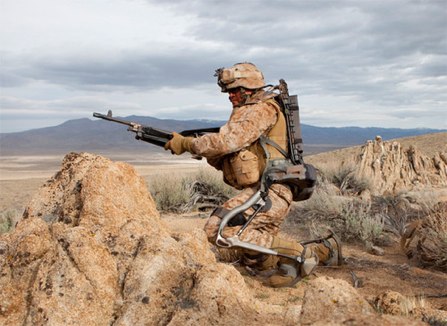Latest Gear Live Videos
DARPA looking to control the minds of soldiers

Posted by John Kilhefner Categories: Science,

DARPA is looking to get their hands on soldiers minds from the outside in, by using a gadget that installs in the helmet to regulate things such as alertness, cognition, pain, and psychiatric well-being.
William Tyler, a neuroscientist from Arizona State University has been working with funds from the Army Research Laboratory for several years, and his work has caught the eye of DARPA.
The mind-control device basically works through a “transcranial pulsed ultrasound” method to stimulate brain circuits from outside of the skull. This is much more convenient than other deep-brain approaches that require invasive surgery to implant electrodes and the like. Furthermore, the technology has proven capable of penetrating deep brain regions, and can zero in on specific brain zones as small as two millimeters.
The device fits snugly into a soldiers helmet and is controlled by a microcontroller. The ultrasound of the device stimulates different brain regions to improve soldier alertness and cognition, and relieve stress and pain, and other traumatic brain injuries.
We’re not too far off from a Metal Gear Solid universe after all.
Read More  | Wired
| Wired
Advertisement
Lockheed Martin HULC Military Exo-skeleton

Posted by John Kilhefner Categories: Misc. Tech, Science,

Lockheed Martin has at least brought us into the era of exo-skeleton suits with their Human Universal Load Carrier, or ‘HULC’ for short. HULC works by transferring weight carried on the soldier to the ground by way of its titanium (sorry, no adamantium just yet) legs. While the exo-skeleton itself weighs about 53 pounds, it also manages to transfer its own weight so the user hardly notices the exo-suit is there. The suit is also tauted as having a wide range of natural movements, managed by an inboard computer that mirrors every movement of the wearer. This means that soldiers can run, jump, and crawl without being restricted by the exo-skeleton. HULC allows for the soldier to move heavy loads across rugged terrain without breaking so much as a sweat, hence the name ‘HULC’ (Hulk). We don’t know if this name was intentional, but the similarities are striking. Perhaps we can get some adamantium claws and regenerative shields too while we’re at it, Lockheed?
Check out a video after the break.
Click to continue reading Lockheed Martin HULC Military Exo-skeleton
BigDog Balances in any Terrain

Posted by Sheila Franklin Categories: Design, Misc. Tech, Science, Videos,
Funded by DARPA, Boston Dynamics has developed the BigDog. About the size of a goat, it also has the dexterity of one. The gas-powered bot’s control system keeps it balanced so that it can navigate on all types of terrains. Sensors monitor such aspects as hydraulic pressure, oil temperature, engine temperature, rpm, and battery charge. Its legs move in an animalistic way and if something interferes, it simply absorbs the shock and carries on. Watch what happens when some dude decides to give it a kick.
Read More  | Boston Dynamics
| Boston Dynamics
2007’s Ten Most Popular Episodes of Bleeding Edge TV

Posted by Andru Edwards Categories: Apple, Smartphones, CES, CES 2007, Features, Handhelds, Mods / Hacks, PC / Laptop, Product Reviews, Software, Transportation, Video Games, Videos, Wireless / WiFi,
We know we are a couple days late, but being the extreme hardcore rockers that we are, we weren’t coherent enough to push out our top 10 most popular episodes of Bleeding Edge TV, Gear Live’s technology video show. Or something like that. Anyhoo, click through to check out the ten videos that were viewed the most in 2007. If we’ve learned anything from compiling the list, it’s that you guys love yourselves some iPhone, Bluetooth, AMD, and video games. Exclusives also seem to strike your fancy.
Click to continue reading 2007’s Ten Most Popular Episodes of Bleeding Edge TV
Latest DARPA Urban Challenge is Successful

Posted by Sheila Franklin Categories: Design, Misc. Tech, Science, Transportation,
 This past weekend, the Defense Department’s Urban Challenge 2007 took place in the desert between LA and Las Vegas. Driverless, the computer-run vehicles had to maneuver around neighborhood streets and obstacles at a deserted AF base. Although “Junior,” Stanford’s 2006 Volkswagen Passat station wagon diesel, crossed the finish line first, the grand prize went to the Tartan Racing team, based on safety as well as speed. Stanford was second, followed by team Victor Tango. This time, 6 of the 11 finalists crossed the finish line. We can see why the military would be interested in this technology, especially when you consider its shock value application. Check out a video we shot of the Carnegie-Mellon team qualifying for the DARPA event.
This past weekend, the Defense Department’s Urban Challenge 2007 took place in the desert between LA and Las Vegas. Driverless, the computer-run vehicles had to maneuver around neighborhood streets and obstacles at a deserted AF base. Although “Junior,” Stanford’s 2006 Volkswagen Passat station wagon diesel, crossed the finish line first, the grand prize went to the Tartan Racing team, based on safety as well as speed. Stanford was second, followed by team Victor Tango. This time, 6 of the 11 finalists crossed the finish line. We can see why the military would be interested in this technology, especially when you consider its shock value application. Check out a video we shot of the Carnegie-Mellon team qualifying for the DARPA event.
Read More  | USA Today
| USA Today
The Bleeding Edge 174: DARPA Grand Challenge Qualifier: Carnegie Mellon and GM’s BOSS Vehicle

Posted by Andru Edwards Categories: Design, Features, Mods / Hacks, Transportation, Videocasts, Videos,
Read More  | The Bleeding Edge
| The Bleeding Edge
Bleeding Edge TV 174: DARPA Grand Challenge Qualifier: Carnegie Mellon and GM’s BOSS Vehicle

Posted by Andru Edwards Categories: Full Episodes, Gizmatic, Hack Attack, Design, Features, Transportation,
We visited one of the fifty or so groups participating in the DARPA Urban Challenge during one of their qualifying rounds. In case you are unaware, the DARPA Urban Challenge is a charge given publicly to groups who are capable of designing and proving the technology for autonomously driven vehicles. Carnegie Mellon University teamed up with GM to create an autonomous SUV they call “Boss.” In order to participate in November’s 60-mile urban driverless race, they need to pass this benchmark. Check out the video to see Boss pull perfect three point turns and beautifully follow traffic rules - even at four way stops with other cars. We’re crazy excited to see this technology come alive in our society. The team from DARPA is darting back and forth across our country qualifying and disqualifying entries. Some of the remaining companies and teams will bring us autonomously driven cars during our lifetime, its amazing how close we already are.










